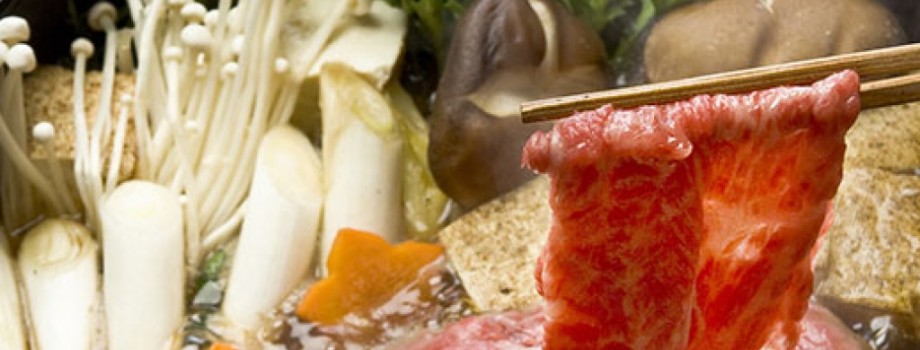Sukiyaki is, without a doubt, one of the Japanese dishes that everyone seems to love. It combines both a salty and sweet flavour, much like teriyaki sauce, and the beef that is used in the dish is very thinly sliced and extremely tender to eat. The dish requires high quality meat with marbling of fat through it to ensure it is nice and tender. In Japan, it is generally a celebration dish eaten in winter after payday, due to the price of the meat.
Traditionally, this meal will be cooked over a portable stove in a cast iron pot. The portable stove is situated on the dining table for everyone to gather around and eat from. New ingredients are added as the ingredients are eaten and disappear. This way of cooking and eating the dish is a great way to spend time with those you care about and creates a dining experience of its own.
Another “authentic” part of this dish is coating the ingredients in raw egg, which you place into your individual bowls. Some people may not consider this very appetising, but the raw egg actually has a sweetness to it, which works very well with the saltiness of the other ingredients. It’s well worth trying!
If you wish to try sukiyaki at home, you can follow this recipe and enjoy it with friends and family.
Sukiyaki Recipe
Ingredients
800 g of finely sliced scotch fillet steak
300 g of firm tofu sliced into 4cm thick slices
380 g packet of shirataki, blanched and drained (this can be found in Japanese food stores, or if you prefer, you can also use cellophane noodles)
8 shiitake mushrooms with stems removed and sliced
1 enoki mushroom, trimmed
1 small Chinese cabbage, stalk chopped into 2 cm pieces (or smaller) with leaves chopped into larger pieces
2 small leeks (white part only) cut into 4 pieces
1 bunch of mitsuba (this can be found in Japanese food stores, and can also be substituted with chervil)
½ a bunch of chrysanthemum leaves (found in Asian food stores) with the stems trimmed
2 tbsp of vegetable oil
Steamed short grain rice, miso soup and 4 beaten eggs (optional) to serve
Sweetened soy sauce
60 ml (¼ cup) good-quality sake
200 ml Japanese salt-reduced soy sauce
200 ml mirin
75 g caster sugar
Method
- Place the beef, noodles, tofu, vegetables and herbs on a large plate.
- Start to make your sauce by placing sake, soy, mirin, sugar and 100ml of water in a small pan, bringing it to the boil. Remove from heat once it boils but keep it warm.
- Using a heavy based frying pan, place on high heat and add the oil. Brown the meat for about 30 seconds on each side. Keep the meat a slight shade of pink as it will continue to cook slightly the longer it is in the pan.
- Follow the packet instructions to cook the noodles of your choice. Shirataki noodles do not need much cooking time, however parboiling is recommended to remove some of the odour of the noodles. The noodles can then also absorb more of the sukiyaki sauce flavouring.
- Add the tofu, noodles, cabbage and vegetables around the beef. Keep all of the ingredients separated, with meat in one section, vegetables in another section and so on.
- If using shirataki noodles, be sure to keep it sectioned well away from the beef, as the noodles contain a compound that can make meat tough.
- Add the sauce until it almost covers the ingredients.
- Add the mitsuba and chrysanthemum leaves (if using). Reduce the heat to a low setting and simmer for approximately 4 minutes or until the vegetables are tender.
- Cover the pot whilst simmering to continue to cook the ingredients slowly.
- Serve with steamed short grain rice and miso soup.
- Prepare a raw egg by beating it and adding it to a serving bowl for each person. Dip the meat into beaten eggs if desired.
- As the liquid begins to get low in the dish, add more sauce.
- Continue to add more ingredients as other ingredients get eaten. The warm pot will quickly cook up any added ingredients while other ingredients are still being eaten.
If you have leftover broth, reserve it for use the next day with udon noodles, as is traditional in Japanese culture.






 (4 votes, average: 4.50 out of 5)
(4 votes, average: 4.50 out of 5)